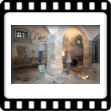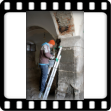REŠTAUROVANIE - HraMoKa
HRAMOKA
REKONŠTRUKCIA I
REŠTAURÁTORSKÁ REALIZÁCIA
Zodpovední reštaurátori:Mgr.art. Miroslav JanštoMgr.art.Štefan Siváň, RESTAURO ATELIÉR s.r.o.Hrad s areálom v Modrom Kameni tvorí dominantu okolitej krajiny. Na základe výsledkov pamiatkového architektonicko – historického výskumu časti prízemia východného krídla kaštieľa a reštaurátorského výskumu môžeme konštatovať, že aj napriek úbytkom pôvodnej hmoty a úpravám, si v zásade zachoval objekt svoje pôvodné kvality a podobu z prestavby z 1. polovice 18. storočia bez zásadnejších zmien dodnes. Interiéri boli výraznejšie pozmenené vytvorením novších otvorov a priečok pravdepodobne z polovice 19. storočia a funkčnej adaptácii priestorov na začiatku 20. storočia. K nasledujúcej celoplošnej úprave interiérov došlo po polovici 20. storočia. Táto oprava interiéru zrejme riešila silne poškodenú vrstvu omietok tak, ako sme poznali ich stav do začatia súčasného reštaurovania. Narušený stav kamenných pilierov bol spôsobený povrchovou degradáciou kameňa. Mechanické zásahy na kamenných častiach boli pravdepodobne výsledkom barokovej úpravy v 30. rokoch 18. storočia a poslednej celkovej úpravy z 20. rokov 20. storočia.Základným cieľom reštaurátorského zásahu bolo zachovanie a v maximálne možnej miere prinavrátenie autentických hodnôt interiérov východného krídla. Otvorením priestoru miestností sa docielil výraz neskororenesančného (ranobarokového) výrazu miestnosti s rehabilitáciou originálnych omietok, podlahy, okenných a dverných otvorov.Reštaurovanie bolo zamerané na odstránenie sekundárnych vápenných omietok nadstavených cementom a odstránenie nánosov, nečistôt, sekundárnych náterov z kamenných prvkov. Farebne sa klenby prispôsobia tak, aby sa celkový výraz priestoru odprezentoval s kompaktným barokovým klenbeným systémom.Kamenné piliere boli očistené od sekundárnych náterov, doplnili sa poškodené lokálne úbytky a odprezentujú sa v pôvodnej hmote, tak aby v celkovom výslednom efekte bola v maximálnej miere zachovaná autenticita kamenárskej práce Terajší reštaurátorský zásah zásadným spôsobom rieši zachovanie a stabilizáciu výtvarných a umeleckých hodnôt neskororenesančného (ranobarokového) priestoru s barokovými úpravami klenieb a obvodových stien interiéru. Okenné otvory sa otvorili do pôvodného stavu z barokovej úpravy. Výplň okien bola realizovaná nová, podľa usmernenia metodika obnovy kaštieľa a projektanta.Reštaurátorský zásah zásadným spôsobom rieši zachovanie a stabilizáciu výtvarných a umeleckých hodnôt prízemia východného krídla kaštieľa modrokamennského hradu.Základným cieľom terajšieho reštaurátorského zásahu je zachovanie a v maximálne možnej miere prinavrátenie autentických hodnôt tejto výnimočnej architektúre. Reštaurátorský zásah bol zameraný na odstránenie dnešných sekundárnych vápenných vrstiev, odstránenie nánosov a nečistôt a sekundárnych zásahov z kamenných a omietkových vrstiev pôvodnej hmoty, tak aby v celkovom výslednom efekte bola v maximálnej miere zachovaná autenticita kamenárskej a maliarskej práce. Reštaurátorský zásah zásadným spôsobom rieši zachovanie a stabilizáciu výtvarných a umeleckých hodnôt interiérov východného krídla.Navrhovaný postup a technológia reštaurovania kamenných prvkov ako aj omietkových vrstiev v interiéri východného krídla kaštieľneho komplexu v Modrom Kameni a výsledkov reštaurátorského výskumu, ktorý preukázal materiálové zloženie jednotlivých častí a ich súčasný stav. Zároveň stanovil počet možných sekundárnych zásahov a úprav. Navrhovaný postup technológie reštaurovania rešpektuje požiadavku autenticity Sanuje hmotnú podstatu týchto súčastí a doplnky, či prípadnú výmenu silne deštruovaných častí kameňa a omietok zvažuje len v nevyhnutnom rozsahu. Vytvára tak predpoklad zachovania tejto pamiatky pre nasledujúce obdobia.
RESTORATION
Responsible restorers:Mgr.art. Miroslav JanštoMgr.art.Štefan Siváň, RESTAURO ATELIÉR s.r.o.The castle of Modrý Kameň and its vicinity is a dominant presence in the region. Based upon the results of the architectural-historical research of a part of the ground floor of the Eastern Wing of the castle and the results of the restoration study we can conclude, that in spite of the loss of the original mass and certain remodelling, the object has, to this day, in principle, maintained its original qualities and the form it acquired during its reconstruction in the 1st half of the 18th century without major changes. The interiors were more significantly modified with new openings and partitions, presumably in the middle of the 19th century and by the functional adaptation of the castle premises in the early 20th century. The next large-scale renovation of the interior took place in the middle of the 20th century, probably because of the heavily damaged plasters, which was the case prior to the current restoration. The stone pillars were damaged by the degradation of the stone surface. Mechanical interventions into the stone were made during the Baroque reconstruction in the 1730s, as well as during its comprehensive remodelling in the 1920s.The basic aim of the restoration was to conserve and, as far as possible, recover the authentic features of the Eastern Wing interiors. The recent reconstruction of the interior has re-established its late Renaissance (early-Baroque) style, including the renewal of the original plasters, floor, and window and door openings.The restoration was aimed at eliminating the secondary lime plasters covered by cement and to remove the deposits, impurities and the secondary coating from the stone parts. The colour of the vaults will match the style of the overall Baroque vaulted system.The stone pillars were cleaned of their secondary coatings and their missing or damaged parts were supplemented to renew their original mass, so that the final effect restores, as much as possible, the authenticity of the stonemasonry. The main goal of the recent restoration was to conserve and stabilize the visual and artistic values of the late Renaissance (early Baroque) premises, the vaults and exterior walls were rebuilt in the Baroque style. The window openings remodelled in the Baroque style were restored to their original state. New window fillings were installed according to the methodology of restoration and the designer´s proposal.The main goal of the restoration was to ensure the conservation and stabilization of the visual and artistic values of the ground floor of the East Wing of the Modrý Kameň Castle.The restoration has fundamentally addressed the preservation and the possible recovery of the authentic values of this exceptional architecture. The secondary lime layers, deposits and impurities were removed, and the secondary interventions in the original stone and plaster layers were eliminated, so that the overall effect maximally preserved the authenticity of the stonemasonry and painting works. The restoration was basically aimed at the conservation and stabilization of the visual and artistic values of the interiors of the East Wing.THE RATIONALE FOR THE PROPOSED INTERVENTIONS AND THE RESTORATION TECHNOLOGYThe proposed method and technology for restoring the stone and plasters in the Eastern Wing of the Modrý Kameň castle complex have been based upon the results of a restoration study investigating the composition and the current state of the particular parts. Moreover, the study determined the number of possible secondary interventions and modifications. The proposed technological procedure of the restoration respects the requirement of authenticity. The technology preserves the material substance of the concerned components and, any replacement of the heavily damaged parts of stone or plasters was done only to a necessary extent, thus creating conditions for the conservation of the monument for the future.
. . . . . . . . . . . . . . . . . . . . . . . . . . . . . . . . . . . . . . . . . . . . . . . . . . . . . . . . . . . . . . . . . . . . . . . . . . . . . . .
 | ||
© Slavo Haľama 2020 | ||











